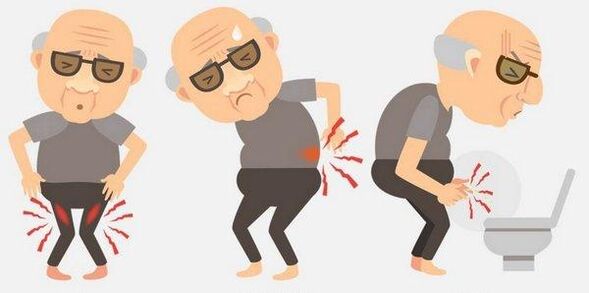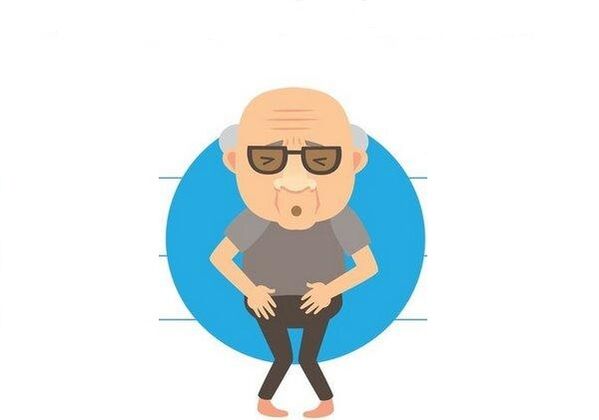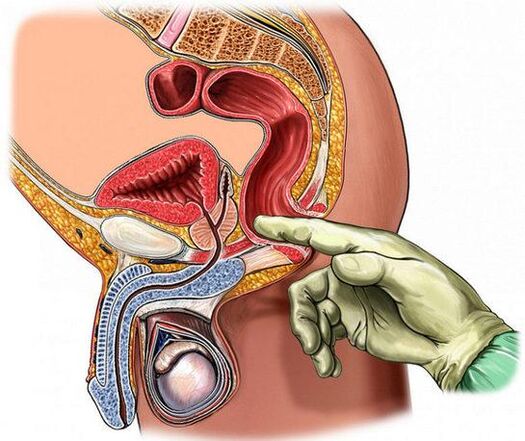The symptoms of prostatitis depend on the form and causes of inflammation of the prostate and the presence of simultaneous diseases. The symptoms often overlap, which significantly complicated the diagnosis.

Chronic prostatitis
Chronic prostatitis develops as an independent disease or as a complication of the acute form of inflammation. During the remission, the symptoms are weak or completely missing, although they are more pronounced to worsen. The clinical picture is similar to acute prostatitis.
The first symptoms of the chronic form of inflammation:
- Frequent urge to urinate;
- Stupid pain in the lower abdomen;
- Complaints in the prostate area (area from testicles to anus) with a long stay in the seating position. Sitting is then impossible for more than an hour due to burning;
- Intermittent, painful urination;
- Blunt pain in the rectum during defecation;
- A deterioration of an erection, symptoms in the groin area during ejaculation is possible.
The above signs in the chronic form of prostatitis do not manifest themselves immediately. This can first be a lubricated orgasm, premature ejaculation, then a man has to strain while urinating, the pain gradually closes together.
In the event of an ultrasound with chronic inflammation, the density of prostate tissues, an increased level of execution of the cloth wave, is observed. In the presence of cysts, it decreases or increases in the calculation of calculations (stones), sclerosis stove (sealing from connective tissue, which are formed due to recreational processes after acute inflammation). There are more and more in the late stages of the herd of connective tissue and fibrosis. The size of the prostate is reduced. During the visual diagnosis, it is difficult to distinguish it from the surrounding fiber.
Acute prostatitis
The acute form of infectious (bacterial) prostatitis is characterized by rapid development. The severity of the symptoms depends on the degree of damage to the gland. With a Qatarrhal shape (inflammation only affects the channels), a man can only feel minor symptoms during the stress of the groin area. During a finger examination of iron, it is slightly increased and almost painless.
Follicular (astructed inflammation of individual gland loads), parenchymal (inflammatory lesion of all tissues of the prostate) and abscessing (capsules with astrist content are formed) forms by a whole symptom complex:

- Severe pain in the groin area, the rectum, testicles, sacrum on the inner hips of the hips, gives up in the penis.
- Fever, general weakness. The active development of pathogens provokes the body's poisoning with inflammatory products.
- Standing down when urinating, a feeling of incomplete emptying of the bladder (due to the irritation of sphincter and urethra mucosa).
- Surious unloading from the urethra (pus comes from the channels of the prostate and opens up in the urethra).
- Heavy of the severity in the perineum.
- Attacks of fast heartbeat.
- Wurmurine with purulent threads. Blood can appear.
With a parenchymal form of prostatitis, painful cramps and pulsating pain in the rectum make it difficult to empty. Small relief only occurs in a pose that lies with pressed legs. The inflammation of the prostate often extends to the rectum, then the mucus begins to be extracted from the anus. The urination against the background of a parenchymal shape can stop completely due to the severe edema of the gland.
External signs of acute prostatitis with ultrasound:
- Expansion venous plexus. The vascular pattern is expressed more clearly;
- Expansion of the channels and capsule of the gland (swelling, uneven rise, stinging the contours);
- Increased degree of reflection of the shaft with fabric;
- The seed bubbles on the sides of the prostate are asymmetrically due to a heterogeneous filling, the channels that remove the seed are expanded.
MRI or CT is prescribed with suspicious neoplasms.
Stagnating prostatitis
The stagnation of prostatitis (it is also known as bacterial in the absence of infections) can occur in men young and older age. The main symptoms are similar to infectious chronic inflammation. A characteristic feature is that the discomfort of the urine system is manifested and mainly improved due to long -term sexual abstinence. A deterioration can cause violent expansion of sexual intercourse, a non -Coral orgasm (sex without real emotional color). A painful urination (hiking) is usually observed in the morning. If the day before was a complete orgasm, there are no cramps.
In this type, prostatitis is the amount of leukocytes in the secret of the gland does not exceed the norm, there is no pathogenic flora in the third part of the urine.
Calcular prostatitis
Calcular prostatitis has no specific symptoms. The presence of stones (calculation) in the gland does not mean the automatic development of its inflammation. In terms of physical exertion, background pain can intensify. The migration of stones through the channels sometimes provokes the appearance of blood in the urine.
Calculations are found during an ultrasound of the prostate. Due to an increased density, they reflect the waves emitted by the device more effectively.
Characteristics of the manifestation of prostatitis in young and mature age

The symptoms of different forms of prostatitis do not depend on the age category of a man. Young people actively live sexual life and often develop an acute form of infectious inflammation with the corresponding pronounced signs.
Chronic prostatitis is diagnosed in men a few years after the start of sexual activity. During this time, due to the activity of hidden infections, the structure of the prostate is violated and its cellular immunity is reduced. The symptoms occur at a time when pathological changes are already irreversible.
Mature men mainly suffer from urine disorders, periodic stupid pain in the perineum and erectile dysfunction. Licking prostatitis at this age is tightened by stagnating processes in the pelvis against the background of androgenic failure and muscle tone loss.
When and to whom to contact
Each of the above symptoms is the reason for contact with the urologist or in the andrologist (diagnosis of prostatitis in clinical and domestic conditions). Many men avoid going to the doctor because a negative attitude to examine the prostate with a finger through the anus or true (transctal ultrasound). If the patient categorically rejects these types of studies, the doctor offers transabdominal ultrasound - if the sensor leans against the lower abdomen. The bladder should be filled (drink only one hour before the 350 ml liquid).
Based on the results of the ultrasound, the doctor determines the type of lesion of the tissue of the prostate, which surrounds its tissue and bladder. In order to identify the cause of the inflammation, it is necessary to urine, blood, prostatic secret (you need a rectal gland massage), in some cases and a sperm.
What diseases have similar symptoms
Many diseases have similar symptoms to prostate. First of all, it is a cystitis (inflammation of the bladder). It is characterized by frequent urge to the toilet, smeared in the lower abdomen, pain during urination, the muddy urine, sometimes with blood. Maybe a slight increase in temperature.
In men over 45 years, the glands and cancer of the gland are mainly excluded. Inflammation against the background of these pathologies are often a secondary sign. The symptoms of glandular cancer are similar to the manifestations of a chronic form of prostatitis: periodic urine disorders that pull pain in the groin area. The prostate is painless with a finger study, but there are dense knots in its structure.
Distant night -urination, a sluggish urine beam, a feeling of incomplete emptying of the bladder, a drop from the urethra and the heaviness in the perineum are characteristic of adenoma. The picture is clarified by palpation and ultrasound: the contours of the prostate have been preserved, the consistency is elastic, the surface is smooth, the iron is almost painless.
Urine and pain disorders in the groin can occur with non -infected prostate stones - calculations are available, but around them there is no cheap environment for accession to pathogens. In this case, discomfort in the perineum provokes physical activity, ejaculation. With the feeling of a prostate under the fingers, the crisis (crunch of stones) can be felt, the body of the gland is dense, banging, moderately painful.
The urine disorders, which are characteristic of the chronic stage of the disease, are also characteristic of the sclerosis of the bladder of the bladder (obstacle in the urethra in the form of the praise of the cutting muscle). Pathology is often the result of a longer prostate. It is rarely diagnosed in men under the age of 40.
In chronic prostatitis, extended venous nodes (internal hemorrhoids) are often taken. They can only be found with a special diagnostic tool. Symptoms:
- Pain in the anus, the sacrum and the step;
- Erection violations;
- Strengthening the pain in the rectum and in the perineum during bowel movements or the longer finding in a seated position.
The contours and consistency of the prostate are unchanged. In their secret, pathological changes are missing.

Pain in the area of the anus and the perineum occurs with deputy inflammation of the rectum. A characteristic feature is a strong burning feeling in the anus during and after the defecation that conveys the penis and the step. There is an urge to see frequent urination (every 20-30 minutes) in the Lacus urine. Prooftite often develops at the same time as prostatitis. In this case, parallel therapy is required for both diseases.
The symptoms of prostatitis are also manifested with the gland tuberculosis. In the risk zone of a man between the ages of 20 and 40. In the early stages of development, the disease is almost asymptomatic. Occasionally, slight pain in the rectum and perineum occur. Violations of urination begin against the background of the participation in the pathological process of the glandular process and communicate the channel that pronounces urine.
With tuberculosis, purulent cavities form in the body of the prostate. When you break through, the content flows into the urethra and is released from the penis during stool. Bacteria that fell into the ureter stimulate the mucosal membrane and produce a quick and painful urination. The pus can spread to the rectum through fiber. In this case, temperature, weakness, sweating and weight loss increases.
Diploma
The prostate gland through the nerve plexus is closely associated with other pelvic organs, whose inflammation lend symptoms such as prostatitis. The doctor must distinguish prostatitis from other diseases (distinguishing) and related identification. The patient should not surprise that the examination of prostatitis symptoms not only depends on the iron but also on other organs, in particular on the rectum. It is important to exclude your participation in the formation of pain and urine disorders, otherwise the treatment is ineffective.

























